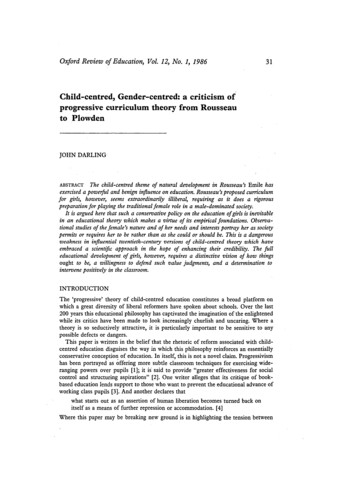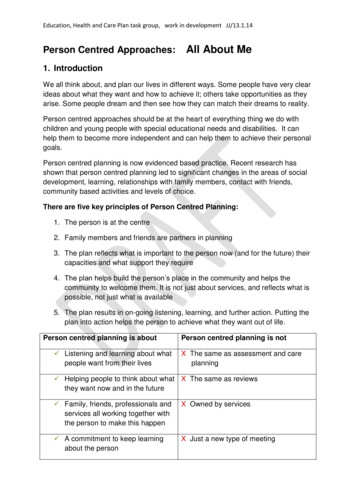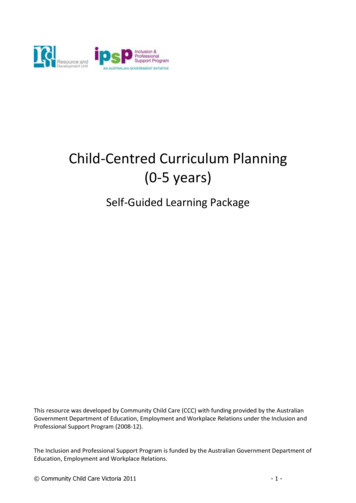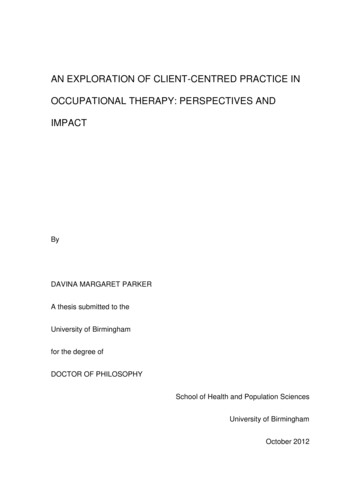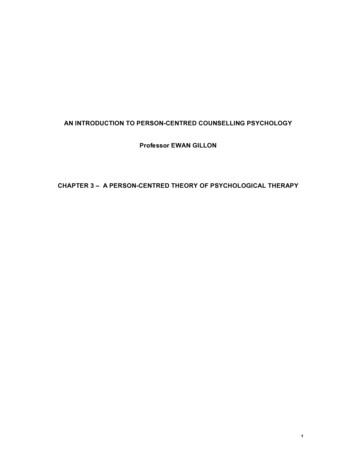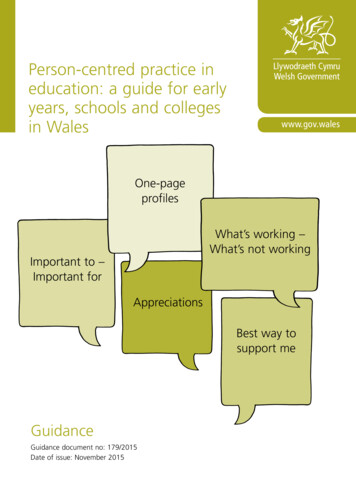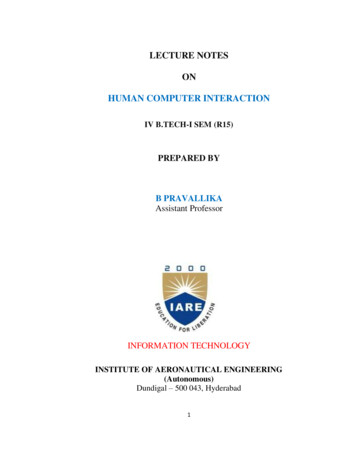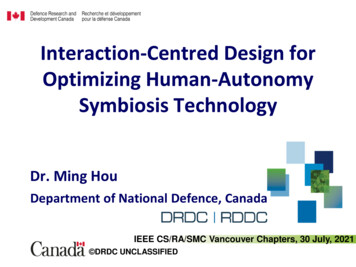
Transcription
Interaction-Centred Design forOptimizing Human-AutonomySymbiosis TechnologyDr. Ming HouDepartment of National Defence, CanadaIEEE CS/RA/SMC Vancouver Chapters, 30 July, 2021 DRDC UNCLASSIFIED
Outline DRDC Toronto Research Centre (Who) Human-Autonomy Symbiosis Technology (WHAT) Interaction Issues with AI/Autonomy (Why) Interaction-Centered Design for Optimization (How) Application Examples of Interaction-Centered DesignApproach (Where and When)
DRDC Toronto Research Centre (TRC) & Canadian ForcesEnvironmental Medicine Establishment (CFEME)DRDC TRC is Canada's centre of excellence forhuman effectiveness science and technology inthe defence and national security environment.Environmental Medicine, physiology, psychology,sociology, and human factors expertiseEmerging Areas for Human Effectiveness:Human-autonomy teamingHuman interaction with digital media (VR and MR)Human interaction with mobile computingSimulation-based training and acquisitionThe use of cognitive modelling or AI to understand andenhance human effectiveness3
MissionTo enhance theeffectiveness and ensurethe health and safety ofthe human in anyhuman-machine systemor adverse environment.TRC was founded in 1939, insupport of Canada’s war effort,under the leadership of Nobel PrizeLaureate, Sir Frederick Banting.
The Only Human Centrifuge in CanadaSimulates the rapid-onsetG-forces experienced bypilots flying highperformance aircraft.Used for Research andDevelopment (R&D) inaircrew protectiveequipment, aircrewtraining, and medicalassessment.
The Unique Diving Chamber in the WorldSimulates underwaterenvironments formilitary and commercialapplicationsHuman-rated withmaximum pressure 17.2MPa (1725 metres)Selection and trainingfor astronauts
The Only Unmanned Aircraft System (UAS)Command & Control (C2) Center in the World7
Outline DRDC Toronto Research Centre (Who) Human-Autonomy Symbiosis Technology (WHAT) Interaction Issues with AI/Autonomy (Why) Interaction-Centered Design for Optimization (How) Application Examples of Interaction-Centered DesignApproach (Where and When)
AI & Robotics, the 4th Industrial RevolutionAccording to theWorld EconomicForum, AI andRobotics will bepervasive tomany domains ofhuman activity
ImpactonHuman Cognitive CapacitytowardsHuman-Autonomy Symbiosis
Evolution of Human Cognitive Capacityhttps://jeevanshu.wordpress.com/
Evolution of Human CapabilitiesVastly expanded humanintelligence (predominantlynonbiological) spreads throughthe universeEpoch 6 The Universe Wakes UpPatterns of matter and energy in the universe becomesaturated with intelligent processes and knowledgeEpoch 5 Merger of Technology andTechnology masters the methods ofbiology (including human intelligence)Technology evolvesHuman IntelligenceThe methods of biology (including human intelligence) areintegrated into the (exponentially expanding) humantechnology baseEpoch 4 TechnologyInformation in hardware and software designsBrains evolvesEpoch 3 BrainsInformation in neural patternsDNA evolvesEpoch 2 BiologyInformation in DNAEpoch 1 Physics & ChemistryInformation in atomic structuresPage 29 “Singularity is near”Amazon.co.uk
C3: Capability(Tech), Capacity(Human) , Complexity(Env)Brain Computer Interfacehttps://ugs.utexas.eduControl of a swarm of drone with mindengineering.com wetalkuav.comRobonaut co-worker in spacewww.nasa.govElectronic tattoo display runs on bloodphys.org
Outline DRDC Toronto Research Centre (Who) Human-Autonomy Symbiosis Technology (WHAT) Interaction Issues with AI/Autonomy (Why) Interaction-Centered Design for Optimization (How) Application Examples of Interaction-Centered DesignApproach (Where and When)
HOWEVERIssues of Human-Autonomy Symbiosis (HAS) Technologywith AI Enabled and/or Computerized Decision-Making: Transparency Cognitive load Trust Accountability Legal and Ethical Aspects Policy and Regulations
Death by AlgorithmThe errant algorithm went undetected for 9 yearsMay 2017, the U.K.Health Ministerannounced a“computer algorithmfailure” caused about450,000 patients tonot be invited fortheir final breastcancer screening. Anestimate suggestedthat between 135 and270 women mighthave died prematurelyas a result of thisblunder.The U.K. Governmentsaid there were still309,000 women alivewho missed their finalscreening.“NHS would revise itsinvestment figure toinclude the 100 millionthat many lawyers feelthe government willneed to pay out incompensation for thislatest case of avoidableharm”Source: in-uk-due-to-algorithm-failure
Psychopath AI showing horrors of human biased A MIT AI machine tested how specific data fedinto an algorithm can impact “outlook”. Themachine, named Norman was fed with grislyimages and went through Rorschach test to“calculate” his mental health with terrifyinghttp://norman-ai.mit.edu/#inkblotresults when responding to images:Norman SeesImagesStandard AI SeesMan is shot dumped from carAn plane flying with smokecoming from itMan is murdered by machinegun in broad daylightA black and white photo of abaseball gloveMan is shot dead in front ofhis screaming wifeA person is holding an umbrellain the air Demonstrates: dangers of biased and prejudice. Norman onlyresponds in horror because that’s all he’s been trained. (Howcan we regulate human bias in AI?)
Facebook Shuts down AI Robots due to FEAR Facebook challenged two AIchatbots to negotiate a trade,attempting to swap items withassigned values Watched over by Facebook AIResearchers and Linguists whorealized the two AI robots werequick to break down thenegotiations. The robots chanted ateach others in a language that wasincomprehensible to humanSource: 6.html
Rise of AI Machines:the World’s First Android CitizenIn November 2017, a robot Sophia was givencitizenship of Saudi Arabia – the first robot given legalpersonhood anywhere in the worldHowever, this AI robot says that she wants to destroy Humans Source: bot-citizen-sophia/Source: de. fanpop.com
AI Will ‘transform or destroy’ Society“Success in creating effective AI, could be thebiggest event in the history of our civilization.Or the worst. We just don't know. So wecannot know if we will be infinitely helped byAI, or ignored by it and side-lined, orconceivably destroyed by it, StephenHawkingbusinessinside.comUnless we learn how to prepare for, and avoid, thepotential risks, AI could be the worst event in thehistory of our civilization. It brings dangers, likepowerful autonomous weapons, or new ways forthe few to oppress the many. It could bring greatdisruption to our economy."
Design Flaws and Catastrophic Consequences(Loss of 228 lives 12 years ago)1 June 2009, Air France Flt 447 from Rio de Janeiro, Brazil to Paris,France crashed into the Atlantic Ocean. The accident is thedeadliest in the history of Air France, and the deadliest aviationaccident involving the Airbus A330.http://www.spiegel.deIntelligent Adaptive Systems: An Interaction-Centered Design Perspective (Hou et al., 2014)21
But we learned from our mistakes right?However, History Ain’t Changed!We learn in A HARD WAY with the price of human lives22
More Catastrophic Consequences(loss of 346 lives within only 5 months in 2018/2019 due to anuncontrollable AI-enabled system with autonomous functions:Maneuvering Characteristics Augmentation System (MCAS) onBoeing 737 MaxTeknologi.idreuters.com23
Design Failure of MCAS on Boeing 737 MaxThree of five main reasons for the crashes:1. Pressures to update design swiftly andinexpensively (cost reduction),2. Faulty assumption that pilots couldrecognize and override a malfunction ofthe system within a few seconds,3. Did not comply with regulations andjeopardized the flying public safetySources: Majority Staff of the U.S House Committee on Transportation and Infrastructure.(2020). Final Committee Report: the design, development, and certification of the Boeing 737Max.TheFlightChannel. (2019, November 19). Boeing 737 MAX Crashes Immediately After Takeoff Here's What Really Happened to Flight 302 [Video].24
System Design and Human Factorswhen transition interaction from “on-the-loop” to “in-the-loop”15 Jan 2009, US Airways Flt 1549 lost engine power after abouttwo minutes departed from LaGuardia Airport in New York City.The pilot (Capt Sully) made a quick decision (100 seconds) toland safely in the Hudson River and all 155 people survived.Page 7Intelligent Adaptive Systems: An Interaction-Centered Design Perspective (Hou et al., 2014)
What a Real Life Story in a HollywoodMovie “Sully” Tells About?Human Factors and Interactions26
Outline DRDC Toronto Research Centre (Who) Human-Autonomy Symbiosis Technology (WHAT) Interaction Issues with AI/Autonomy (Why) Interaction-Centered Design for Optimization (How) Application Examples of Interaction-Centered DesignApproach (Where and When)
System Design Philosophy1. You may believe in machine, however, the besttechnology might not be the most advanced oreven the first invented, but the safest to human;2. Believe more in human in emergency as human hasnot only intelligence, but more importantly,wisdom, ethics, and guts in our heart; and3. Design not only for technology but a trusted andcollaborative partnership between human andmachine in a human-autonomy symbioticrelationship.28
A Human-Autonomy Symbiosis SystemAs represented by a human operator (i.e., pilot), amachine (i.e., aircraft), and the interface that allowsthem to interactIntelligent Adaptive Systems: An Interaction-Centered Design Perspective (Hou et al., 2014)
A Conceptualized HASSystem Knowledge of mission plans/goals Knowledge of mission time-lines Knowledge of mission tasks/activities Knowledge of mission environment Mission Plan/Goal Monitoring Control (task/activities) Monitoring Sensor (environment) ADAPTATIONENGINECompareOPERATORSTATEASSESSMENT Psychophysiological Monitoring Behavioural Monitoring Model of human cognition Model of human control abilities Model of human communication Model of human interaction
Conceptual Frameworkof An Human- AutonomySymbiosis (HAS) HMI Design Guidelines HCI Principles Knowledge of mission plans/goals Knowledge of mission time-lines Knowledge of mission tasks/activities Knowledge of mission environment Mission Plan/Goal Monitoring Control (task/activities) Monitoring Sensor (environment) MonitoringFeedback LoopAdapt IONENGINEAutomation / AidCompareOPERATORSTATEASSESSMENT Psychophysiological Monitoring Behavioural Monitoring HMI Design Guidelines Automation-design Principles(Hou, Gauthier, & Banbury, HCI 2007)(Hou, Banbury, & Burns, 2014;2020) Model of human cognition Model of human control abilities Model of human communication Model of human interaction
Evolution of Design Strategy for HASTechnology - centeredUser/human - centeredInteraction - centeredInterfaceAutomationIntelligent Adaptive Systems: An Interaction-Centered Design Perspective (Hou et al., 2014)
Interaction-Centered Design (ICD) Strategic Roadmap1. Conduct Taxonomic Analysis (Contextual Domain)2. Select System Design Framework (for Interactions)3. Select Analytical Techniques (System Requirements)4. Select Design Methodology (Hardware and Software)5. Select Operator-State Monitoring Approach (Meatware)6. Comply with Design Guidelines (Domain Standards)Hou, et al., 2007 (Journal of Cognitive Engineering and Decision Making)Hou, et al., 2011 (IEEE Transactions on Systems, Man, and Cybernetics -- Part C)Hou, et al., 2014; 2020 (Intelligent Adaptive Systems – An Interaction-Centered Design Perspective)
An Agent-Based Conceptual Framework forHAS Design34
Selection of Analytical Techniques35
Goal/Task Analysis for Functional Requirements
Selection of Operator Monitoring Approaches
Design Issues to Address – W5 for an Integrated Project Team (e.g., Project Manager,Design Engineer, and Systems Developer, etc.)Why (rationale, perceived need, perceived benefits)What (mission, task -- domain context)Where (working environment)When (timing, frequency, duration)Who (intended users/operators/stakeholders)How (use case/scenario – interaction)38
Peer Reviewed: Interaction-Centered Design (ICD) forA Collaborative Partnership (Human & Autonomy)“ Setting the agenda forthe coming years as HumanFactors practitioners grapplewith the demands that IASwill make on its operatorsand a clear statement of theimportance of collaborationand partnership betweenHuman and AI, and outlininghow this can be achievedthrough interactionA must read for any serious professional in(centred) design ”academia, government, or industry,interested in building and using twenty-firstBook Review: Intelligentcentury human-computer symbiosisAdaptive Systems. C. Baber,technologies University of Birmingham,Ergonomics, 2017, Vol. 60,No.10, 1458-1459.Dr. Dylan Schmorrow, Executive VP and Chief Scientist,39Soar Technology, Inc., Former DARPA Executive
Adopted as Strategy, Principle & Guidancefor NATO Standards Development“ (HAS) capability development through building trust andprocess ”LGen S. Kindsvater, NATO Deputy Chair of Military CommitteeNATO Joint Capability Group Unmanned Aircraft Systems Spring Summit, 14/06/21STANREC 4811: Guidance on Sense and STANREC 4685: Human Systems IntegrationAvoid for Unmanned Aircraft SystemGuidance for Unmanned Aircraft System
IMPACTS: A Trust Model for Human-AI Teamingand Human-Autonomy InteractionHou, M., Ho, G., & Dunwoody, D. (2021), Special Issue on “Human-MachineTeaming in Military Contexts”, Journal of Human-Intelligent Systems Integration.
Outline DRDC Toronto Research Centre (Who) Human-Autonomy Symbiosis Technology (WHAT) Interaction Issues with AI/Autonomy (Why) Interaction-Centered Design for Optimization (How) Application Examples of Interaction-Centered DesignApproach (Where and When)
HAS Interaction Issues Transparency Cognitive load Trust Accountability Legal and Ethical Aspects Policy and Regulations
Atlantic Littoral UAV ExerciseMulti-UAVsSearching forTerrorist VesselsRCAF Maritime Patrol Aircraft CP14044
Information Overload
Soldier-Robot Teaming
1st Canadian Intelligent Tutoring System (ITS) Students can question virtual witnesses and receivereal-time and adaptive instructions based on theirresponse and performance to learning context inImprovised Explosive Device (IED) disposal scenario.An integrated suite of ITS in Canadian Armed Forces(CAF) Counter-IED training course with improvedefficiency, effectiveness (94%), and reduced cost.Patent application filed in both Canada and US.1. Select “Threat Assessment”tab to review all previous cluesand how you classified them2. Select “Complete Threat Assessment” to makeyour final threat assessment and finish game.
Challenges of Weapon Engagement1. Lack of doctrinal knowledge on Rules of Engagement (ROEs), international Laws ofArmed Conflict (LACs), and policies or regulations2. Complex, lengthy, and error-prone target engagement processes significantlycontribute to:a. loss of SA at individual and crew levels for both collocated and distributedteams;b. Distrust of machine/technology partner (e.g., Autonomy/AI)c. Potential mission failure
Optimized Interaction for TrustedHuman-Autonomy Collaborative PartnershipThe focus was ontransparency for decisionmaking (intelligent andadaptive) with increasedsituational awareness andreduced workload to optimizetransition of humaninteractions (with AI-enableddecision aid) between “onthe-loop” and “in-the-loop”.
Authority Pathway forWeapon Engagement (APWE)An AI agent-based HAS with a weaponengagement stateboard for increased processtransparencyEnsures tasking authorities to follow ROEs,LACs, and target engagement procedures(legal, ethical, accountability, and trust).Automatically and dynamically updates thestatus of each step required to release aweapon, based on intelligence inputs fromUAS crew, external authorities, and AI agents.Adapts its interface to UAS crew and otherexternal users based on different ROEs andLACs information and communicationrequirements
Evaluation on Operational Effectiveness,Interoperability, & Military UtilityTTCP Autonomy Strategic ChallengeAutonomous Warrior 2018 ExerciseUNCLASSIFIED
Operators’ Feedback1. “ brilliant idea (to visualizeengagement status fortransparency) ”APWEDisplay2. “ massive fan; logical and greatvisibility of engagement status."3. “ intuitive use for taskingauthority to interact (with CDEand AI agents during targetengagement process) ”4. “ supports effective humanautonomy partnerships (teaming).”5. “ the most trustworthy ofthe whole thing (integratedC2 systems) because theincreased SA and reducedworkload (and potentialhuman error) ”UNCLASSIFIED52
Take AwayInteraction-Centered Design (ICD) strategy andmethodologies are needed to mitigate potentialrisks given difficulty in designing fully fail-proofIntelligent Adaptive Systems (IASs) in the new eraofHuman-Autonomy Symbiosis TechnologyPage 29 “Singularity is near”
A habit to comply with Regulations andStandards, follow established Processes,and then enable Safety and Trust.54
THANK YOU and QUESTIONS?55
Page 29 “Singularity is near” Amazon.co.uk Epoch 1 Physics & Chemistry Information in atomic structures Epoch 3 Brains Information in neural patterns Epoch 2 Biology Information in DNA Epoch 4 Technology Information in hardware and software de
